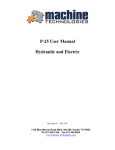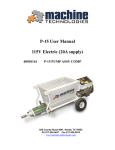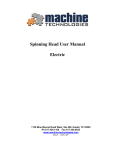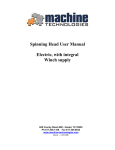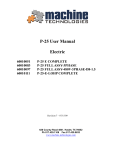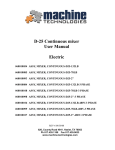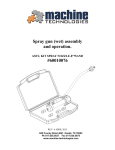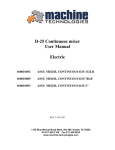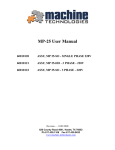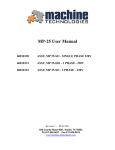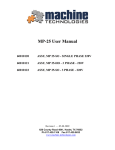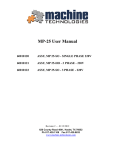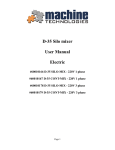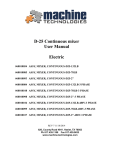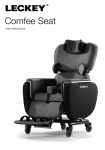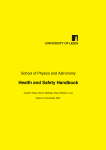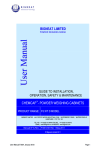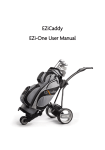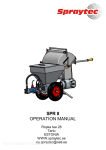Download P-35 User Manual - Machine Technologies
Transcript
P-35 User Manual 60010168 ASSY P-35 PUMP Rev 1 – 01-03-14 620 County Road 4841. Haslet, TX 76052 Ph 817.636.5637 Fax 817.636.5675 www.machine-technologies.com Dear Customer, Before starting this machine please complete the following; Machine Date of purchase………………………………….. Machine serial number……………………………………… Please read the following information contained within this manual and fully familiarize yourself with the equipment. Page 2 Contents Page Section 1 - General Safety information........................................................................... 4 Danger............................................................................................................................. 4 Section 2 - Machine Description ...................................................................................... 5 Function.......................................................................................................................... 5 Machine illustrations..................................................................................................... 6 Machine ....................................................................................................................... 6 Hopper unit................................................................................................................. 7 Front and rear seal location ...................................................................................... 8 Pump Unit ................................................................................................................... 9 Drive unit .................................................................................................................. 10 Drive Shaft with bridge breakers ........................................................................... 13 Universal Drive coupling with axial load pins ....................................................... 14 Section 3 – Transportation and positioning ................................................................. 15 Section 4 – Machine set up ............................................................................................. 16 Section 5 – Machine operation / speed setting.............................................................. 22 General notes for operation ........................................................................................ 22 Section 6 – Simple maintenance and cleaning.............................................................. 23 Seal Greasing................................................................................................................ 23 Front seal replacement................................................................................................ 24 Electrical maintenance ................................................................................................ 28 Section 7 – Notes on wear of rotor / stator pump unit................................................ 29 Stator adjustment ........................................................................................................ 29 Wear issues................................................................................................................... 29 LIMITED WARRANTY POLICY .............................................................................. 30 Page 3 Section 1 - General Safety information Danger Follow these instructions very carefully, in order to avoid injury to yourself or others. Electrically powered machine. Always ensure that all power to the machine has been turned off and isolated before ANY maintenance / repair work is carried out on the machine. Ensure that all guards are correctly fitted before starting or attempting to operate the machine. Ensure that all fasteners are present and correctly fitted before attempting to start or operate the machine. Ensure that the pump unit is correctly fastened to the front of the hopper unit of the machine, and free of damage before attempting to start or operate the machine. The P-35 pump unit can produce, high torques and can generate high voltages. Authorized persons ONLY can use this machine, and must take care at all times. Page 4 Section 2 - Machine Description Function The machine has a drive motor, that turns a universal joint with axial load pins, in turn driving a drive shaft within a material hopper that then feeds a progressive cavity rotor stator pump unit that delivers the material from the hopper to the dispense head via a material hose / hoses. The machine is driven by an electric motor powered by 220VAC 3 phase, via an electronic variable speed inverter supplied by a 3-phase supply of 220VAC. (187268VAC) The drive transmits its rotary action through a drive shaft equipped with bridge breakers, which help to mix and convey the material from the hopper towards the pump unit. The pump unit is a progressive cavity pump unit comprising of a helical rotating “rotor” with the rubber lined “stator”. As material is drawn / fed into the pump unit it is forced through a series of cavities that deform, causing the material to be moved from the hopper towards the outlet. Once the material has reached the outlet it is guided through an output flange assembly, into the dispense hose through to the hose outlet, where typically a spray nozzle is attached allowing, with the assistance of an auxiliary air supply, the material to be “sprayed” on to the substrate. A number of different devices can be fitted to the outlet of the tube for different means of application. For details of these different devices please contact your supplier of Machine-Technologies equipment or Machine-Technologies directly. Page 5 Machine illustrations Machine U-356 rotor stator pump illustrated. Page 6 Hopper unit Page 7 Front and rear seal location Page 8 Pump Unit U-356 – Typical delivery 150 ft³/hr @ 200 RPM **Outputs typical and are subject to material type, moisture levels, application method and as such testing should be performed to establish suitability. Page 9 Drive unit The machine is supplied with an inverter duty, 3phase electric motor drive. Note – GREASE ON A DAILY BASIS Page 10 Electric Drive Module The electronic Drive module comprises of a variable speed frequency inverter, allowing the use of 220VAC three phase power to run the high torque 3 Phase gear motor. The unit is rated at 15 HP providing plenty of power to run the P-35 unit. The module is supplied with an input plug allowing immediate wiring into your own 220VAC three phase supply (Must be carried out by an approved installer). The motor is supplied with a pre-wired plug that fits into the 3 Phase outlet of the drive module. The module has a main power isolator, a combined stop / start push button, a reverse switch, a speed control potentiometer, internal breakers, for each input phase, a large capacity cooling fan in addition to the fan fitted to the inverter, and a remote socket, providing the optional capability for remote operation. Page 11 Page 12 Drive Shaft with bridge breakers The drive shaft couples the motor drive to the pump unit, and allows one to turn the other. The drive is equipped with bridge breakers, which prevent “bridges” being formed through the material in the hopper and at the same time move material towards the inlet of the pump unit. Page 13 Universal Drive coupling with axial load pins The universal drive coupling allows a high torque transfer ability with eccentric movement at one end combined with an axial force transfer via the load pins, thus connecting the main motor coupling to the drive shaft and preventing binding of the coupling due to discharge pressures. Page 14 Section 3 – Transportation and positioning The machine is typically manually transported around the job site using the two carrying handles. The handles swing vertically down and out of the way when not in use. If the machine is to be permanently positioned then they can be removed and stored for later replacement. It is suggested that the unit be placed as close as is practicably possible the discharge location, so that excessive pumping distances can be avoided helping to minimize the loading of the machine. Consideration must be paid to the power cable length and that cable extensions should be avoided to minimize chances for power connection overloads, and faulty hook ups. During transportation ensure that the rear of motor is not damaged or filled with dirt or debris. The fan cowling must be free of ALL obstructions and the fan must be free to rotate at all times to ensure that the motor is correctly cooled. The unit must be placed on level ground to ensure that the hopper has a slight downward slope towards the rotor and stator, helping to ensure that the unit will drain and to help keep the pump inlet primed. Blocking up of the rear wheels is suggested if level ground is not available, but as the unit will have a swinging motion under higher speeds the means of lifting the rear wheels needs to be secure or the pump could fall off and possible damage result to the hopper and or other parts. The Pump electrical drive unit can be placed any where within the range of the 10’ motor connection cable. The cable must not be strained in any way or failure could occur. Generally avoid placing the control unit with a dust stream or overly dusty area. Page 15 Section 4 – Machine set up Unpacking – Generic unit shown actual packing may differ Remove the safety grid from the top of the machine by removing the 4 bolts, clips and washers. Remove the pump unit, pump wedges and the breaker bar from the hopper. Consult the final inspection record supplied in the packing for details of your machine and the items checked prior to shipment. Keep this document for your records. Page 16 Machine assembly Note - generic representations / illustrations might differ from your actual unit. Ensure that the motor wedges are secured and in place. Assemble the breaker bar into the hopper and engage one of the flat ends into the slot in the drive / hauling bracket. Page 17 Rotate the drive shaft by hand until the other flat end of the shaft aligns with the approximate position of the slot in the end of the rotor in the pump unit. Slide the pump unit towards the hopper, over the location shafts, locating the drive shaft into the end of the slot in the pump unit. Page 18 Ease the pump assembly into position, then assemble the two wedges into the slots. Manipulate the pump unit and the wedges until the pump flange is within 1/8” of the hopper flange, then drive the wedges into position until both flange faces are flush. Note: the drive shaft might become tight between the two drive slots during static assembly. Once the unit has been running the compressive force will be reduced or eliminated to within working limits. During pumping the compression will be present, during reverse the compression will be relieved. Do not operate in reverse unless removing pressure in the hoses or excessive wear will result Important Replace the safety grid back onto the top of the hopper and secure using the 4 clips, bolts and washers. Operation of this machinery without the grid in place is prohibited. The output of the pump unit is supplied with a male cam-lock style fitting which threads directly onto the output of the pump, giving a 50mm male connection, suitable for a 50mm female hose cam-lock, and subsequent discharge from the hose via a male camlock fitting. Page 19 Electrical connections 1. Ensure that there are no power connections to the Electronic drive module. 2. Site the drive module within 10’ of the P-35 unit, as this is the fitted power lead length from the electric drive motor to the connecting plug. Try to avoid excessively dusty areas. 3. Obtain supplied connection lead for the 220VAC 3 phase feed to the drive module. The length must be such that the delivered voltage to the drive must be 220VAC, and capable of supplying 50A on each leg / phase. Turn the breakers OFF in the box, and remove it from the bus bar to ensure that no voltage exists on the cables. 4. Make the connection between the drive module and the main distribution box, using the supplied electric plug and your supplied cable. Ensure that the Earth is connected, as well as the AC phases. 5. Connect the plug to the drive module, and ensure that the drive module rotary isolator switch is turned OFF. 6. Replace the breakers into the distribution box, onto the bus bar and turn them ON. 7. Turn the drive module isolator to ON, and listen for the cooling fan to turn on. Page 20 A qualified individual experienced in the use of electro-mechanical equipment must conduct the following. Ensure that there are no persons close to the machine. Ensure that there are no obstructions in or around the machine. Turn the speed control knob to approximately position 3 on the dial. 8. Spray a silicone base lubricant / release into the stator, from both ends, and leave for about a minute. 9. Press the start button and observe the machine to turn the drive shaft forwards PRESS THE STOP button, within 5 seconds or damage will result to the pump unit. The pump turns in a counter-clockwise direction when viewed from the motor end of the hopper when pumping. 10. The machine is now ready for use, by trained and qualified operators. Page 21 Section 5 – Machine operation / speed setting The following are to be completed by trained and experienced persons, familiar with the pumping system provided. 1. Connect a hose to the output coupler on the end of the pump unit. 2. Fill the P-35 hopper with water and a suitable lubricant (dish soap). 3. Place the discharge end of the hose, into the hopper, making sure that the end cannot come into contact with the moving parts inside the hopper. 4. Turn on the machine in the FWD direction and observe fluid to be displaced from the hopper through the hose and then back to the hopper, in a recirculatory manner. 5. Using a suitable collection vessel and a stopwatch, time the volume discharged in a given period. Convert this amount displaced into gallons / minute. Compare this figure with your required figure and adjust the speed accordingly. Do not run the machine with water and lubricant for more than five minutes at a time or damage could result to the pump unit. General notes for operation • • • • • • • • • • • • Grease hauling bracket / drive auger seal daily, with water resistant, corrosion inhibited grease via the grease cert in the motor flange. For starting the pump, Ensure that the speed control is at minimum, and direction control is set to forward. Do not let hopper run dry while pump is running. To stop machine push the stop button. If a hose plugs while pumping, reverse direction on pump to relieve line pressure. Never point hose towards personnel when pump is working. When cleaning the pump, do not remove safety grate while pump is running. Wash out hopper with water and let it run out of the hose. When the hopper is clean run foam balls through hose with clean water. Do not spray water on or in control box. Control box should be wiped down with a damp rag. If access is required in to the hopper, disconnect power source before removing grate. Pump can be disassembled by removing wedges, this facilitates easier transport and final clean up. Pump is supplied with an adjustable stator on some models. The sleeve can be tightened to bring working pressure back to normal range as the stator wears. This should be done in small increments. Over tightening the stator will cause premature wear and heat up material. Always check hoses and cords for wear. The unit runs on high voltages and is capable of high pressures in the hoses. Check the condition of the universal drive coupling, look for signs of wear on the bushings and for possible contact of the triangular drive flange with the coupling disc, and the triangular drive shaft flange with the coupling disc indicating need of replacement. Page 22 Section 6 – Simple maintenance and cleaning The P-35 pump unit is very simple to maintain. The biggest part of maintenance on the P-35 machine is cleaning after a job. Failure to clean properly after use will damage seals, paint, and moving parts due to material build up causing wear. Pay particular attention, when cleaning, to the seals between the Rotor stator flange and the flange on the front of the hopper, to the seal between the motor mounting flange and the rear of the hopper, and to the seal around the drive / hauling bracket fixed to the drive flange at the rear of the machine. Seal Greasing Ensure that the seal between the hauling bracket and the motor is greased each day or after each clean down, with a water resistant, corrosion inhibiting, extreme pressure grease. Grease until a small amount of grease can be seen “oozing” from around the hauling bracket. Page 23 Front seal replacement The illustration shows the front seal, in a deformed state, as would be seen when full of grease and fitted over the hauling bracket / Drive auger. Take special note of the grease groove position of the seal, in relation to the grease hole in the plate and the grease cert. Together they give a path for the grease to get into the cavity. Grease using a high water resistant, high corrosion protection, and extreme pressure type grease, on a daily basis, or after each time the unit is cleaned down Page 24 The seal needs to be replaced once the seal no longer holds grease, is broken or cracked, worn to the same diameter as the drive, indicated by a flat appearance. Once replacement has been identified, then the unit needs to be stripped and thoroughly cleaned, take time to remove old grease and dirt from around the motor shaft seal itself. 1. clean the seal assembly with lacquer thinner of acetone, just wipe with a clean rag do not dip or leave immersed. 2. Clean in a similar manner the counter bore of the football shaped motor flange. 3. Apply a small bead, approx 1/8” of RTV silicone sealant between the counter bore base and the bore, then place the seal assembly into the counter bore making sure that the dowel pins drop into the dowel holes in the flange. 4. Press the seal into place evenly wiping away any excess RTV silicone sealant from outer flange face and the grease port. Leave to cure. 5. Once cured, check that the grease port is clear though the flange and the seal then clear as required. Page 25 Clean the front face of the motor gearbox flange (front part of the motor gearbox itself) is a similar manner to before, and leave to dry. 6. Once dry smear a layer of RTV silicone sealant on the front face of the motor gearbox flange from the outside diameter to the pilot location diameter, then assemble the football shaped motor flange to the gearbox making sure to avoid any repositioning after the flanges have touched, evenly assemble the bolts and washers and evenly tighten. Note repeat the tightening sequence numerous times as each time the sealant will be squeezed from the progressively closer faces. 7. Assemble the Drive spider over the motor output shaft, ensuring that the key is in position in the keyway until the drive is almost touching the seal face. Using a smear of grease around the inner diameter of the seal hole and a suitable hook tool (similar to a small paint can opening tool), hook under the rubber seal then draw up over the drive. In a similar manner to fitting a tire bead over a wheel rim, drag the seal away from the motor, using a circular path to pull the entire seal inner diameter up and over the drive diameter. 8. Fully grease the seal via the grease fitting together with rotating the motor by hand, until grease can be seen oozing from between the seal and the drive. Page 26 Color view of the assembled seal with the seal lip “hooked” up over the outside of the drive coupling Page 27 Cleaning the P-35 on a use by use basis is also a simple process. After the hopper has been emptied as far as possible of product and whilst still workable, squirt water from a hose pipe with a spray nozzle through the grate to the inside of the hopper while the machine continues to run slowly. Pay particular attention to the immediate area around and under the Drive spider attached to the motor, and to the other end being the opening into the stator. Clear away all product from between the drive spider, the flexible coupling and the shaft. Run the hopper until almost empty, then stop the machine and remove the cover from the hopper drain from inside the lower left caster frame and allow the hopper to drain. Repeat the spray down process again if required to remove ALL product from within the hopper and the internals. Note the wedges can be withdrawn from both ends using a hammer to allow the flanges to be separated from the hopper helping with the product removal using the hose pipe. Once clean re-assemble the wedges, thus closing the flanges, and lubricate the rotor inside the stator using a silicone based. Start the machine running slowly and continue spraying the lubricant into the mouth of the stator. Turn the machine off then spray the internals with WD40 or similar de-wetting agent to help prevent rusting on the drive components. Electrical maintenance Disconnect ALL power connections to the control unit. The drive module should not be sprayed with water but wiped with a wet rag to remove debris. The filters covers should be removed and the filters blown clean using compressed air on a regular basis. To clean the electronic drive module, remove the filter covers and the filters. Open the drive module lid then using clean and dry compressed air, blow out the debris from within the control box, paying special attention to the switches. When blowing air across a fan take care not to “over spin” the fan blades and to keep the blow nozzle away from these rotating objects. Ensure that all connections are in good condition, and free from signs of breakage, wear and loose wires. Keep all electrical items away from water or other liquids. Page 28 Section 7 – Notes on wear of rotor / stator pump unit A Rotor is the metal corkscrew looking item that ROTates inside the Stator. A Stator is the STATionary part that the rotor rotates inside. Stator adjustment Some of the Stators supplied are adjustable, some are not. The adjustable units allow the tightening of some bolts, to squeeze together two flanges, which in turn reduce the diameter of the inside of the stator, allowing a tighter fit around the rotor giving renewed ability to produce higher pressures, similar to when the unit was new. D8-1.5 ILLUSTRATED Wear issues Dry running of a rotor-stator pump A screw pump can only work reliably if there is adequate and appropriate lubrication. The lubricant reduces the friction between the rotor and the stator. If this lubricating film is damaged, high temperatures are reached and the elastomer wears within a very short time. Even if dry running lasts only a few seconds with new parts, the effect resembles that of a wheel spin on a car tire, dramatically affecting length of service. The use of simple dish soap or specific water based lubricants mixed with water while hose cleaning, or pump priming can dramatically reduce the negative effects of dry running, and help prolong the natural life of the rotor and stator. Please note. that rotor stator wear is directly related to the amount of work that the unit has to perform. A low-pressure job with a smooth mix will cause less wear than a highpressure job with smooth mix. A low-pressure job with a course mix will wear more than a low-pressure job with a smooth mix. The life of a rotor stator combo will need to be determined on a job-by-job basis, being dependent upon the coarseness of the mix and the amount of pressure required. Page 29 LIMITED WARRANTY POLICY Machine Technologies warrants each of its new machines to be free of defects in material and workmanship under normal use and services for a period of one (1) year from the date of delivery. The warranty is issued ONLY to the INITIAL USER. The warranty period begins when the product is delivered to the initial user or when first put into service, whichever occurs first. Said warranty is void if the machine is subject to misuse, neglect, accident or abuse. Machine Technologies’ obligation under this warranty is limited to correcting without charge, at its warehouse, any parts or parts thereof which shall be returned to its warehouse, transportation/shipping prepaid and upon Machine Technologies’ examination proves to have been originally defective. Correction of such defects by repair or replacement shall constitute fulfillment of all obligations to the initial user. This warranty does not include labor or transportation charges unless specifically identified and authorized in writing by Machine Technologies. Nor does the warranty apply to any unit upon which repairs or unauthorized alterations have been made. The warranty does not apply to normal maintenance service or to normal replacement of certain machine parts which are subject to normal wear (including but not limited to pins, bushings, rotors, stators, hoses, spray caps, spray nozzles, mixing shafts, shaft couplings and connectors, dosing shafts, pump shafts, filter elements and tires). THIS IS A LIMITED WARRANTY AND IS IN LIEU OF ANY OTHER WARRANTIES, EXPRESSED OR IMPLIED, INCLUDING ANY WARRANTY OF MERCHANTABILITY OF FITNESS FOR A PARTICULAR PURPOSE. In no event shall Machine Technologies be made liable for incidental, general or consequential damage, loss or any expense directly or indirectly related and resulting from use or lack of use caused by delay in delivery, parts failure, or any other causes associated with the product use. No person, firm or corporation is authorized to assume for Machine Technologies any other liability in connection with the sale of Machine Technologies products. Page 30






























